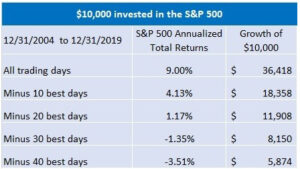
by Joseph P. Trybula, CFP®, AIF®, Diversified Financial Advisors
Economic downturns and turbulent investment markets can make people nervous. Recognize these events as a normal, although undesirable, part of the economic and investment cycles. With that in mind, here are some tips for investors during unpredictable times.
Don’t panic
Some people may be tempted to bail out of their stock investments if markets are having a particularly rough ride. Selling solely because the stock market tumbles may be the worst thing to do.
Stay invested
If you’re investing for a long-term goal — such as a retirement that begins in another decade or more and could last two or three decades — you’ll have plenty of time to ride out market cycles. As the table below shows, missing some of the best days in the market can reduce your gains significantly over the years. An investor who stayed fully invested over the past 15 years would have earned $20,460 more than someone who missed the market’s 10 best days.
Missing the best days in the market substantially reduced returns

If the stock market posted gains and losses every other year, imagine what you would lose by selling after a dip. Where would you put your money? A money market account might earn a steady 1.5%, but, that won’t even keep up with the average long-term inflation rate of 3.1%.
Keep a long-term perspective. It’s easiest to stay the course if you focus on your major life goals and not on the market’s day-to-day or month-to-month movements. Look at your quarterly account statements, stay on top of major current financial events, and plan to do a thorough review of your investments — asset allocation, investment performance and progress toward your goals — once a year.
Dollar cost average
One of the most effective approaches to investing is dollar cost averaging. You simply commit to investing the same dollar amount on a regular basis. When the price of shares in a stock or investment portfolio rises, you’ll buy fewer shares, and when the price dips, you’ll buy more.1
Maintain a diversified portfolio
Diversification lowers your risk because historically not all parts of the market move in the same direction at the same time. Losses in one area may be balanced out by gains elsewhere.2
Know your risk tolerance
If you find stock investments to be too risky for your taste — for example, if you can’t sleep at night because you’re worrying about your stocks — maybe you should consider a safer, steadier ride. Make thoughtful moves. If you make changes to your investments, do so in a thoughtful way, and after careful consideration. Talking with a financial professional could be a good first move.
For more information, contact Joe Trybula at joe@printers401k.com or 800.307.0376.
Disclosures
1. Dollar cost averaging involves continuous investment in securities regardless of fluctuation in price levels of such securities. An investor should consider their ability to continue purchasing through fluctuating price levels. Such a plan does not assure a profit and does not protect against loss in declining markets.
2. There is no guarantee that a diversified portfolio will enhance overall returns or outperform a non-diversified portfolio. Diversification does not protect against market risk.

